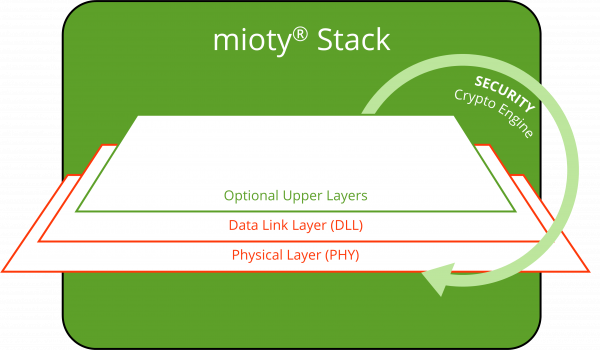You have already dealt with the mioty® technology and would like to find out whether the mioty® Stack fits to you and your products? The mioty® Protocol Stack is a highly efficient and especially robust solution for both Low Power Wide Area Networks (LPWAN) and concentrated industrial networks. With the innovative technology of telegram splitting, it sets new standards in the field of wireless data transmission and is extremely flexible in its application areas. Learn more about the stack features, implemented standards and the stack package in the article.
Stack Features
The mioty® Stack implements two layers:

With the mioty® Stack, a flexible API as well as an interface for externalization of e.g. security functions, a well-designed Hardware Abstraction Layer (HAL) and a consistent look-and-feel of the API is delivered by default for the software library. In the modem application, all API functions are available via the supplied implementation of a serial interface that supports UART, SPI and other ports and provides minimal overhead. Thereby, 1:1 the API of the stack is made available via a serial interface. For particularly sensitive applications, the modem application even offers the option of AES encrypted use of the serial interface.
Likewise, the integration of any type of fixed memory such as EEPROM, Flash or MRAM is supported. Flexible interfaces allow the stack to support hardware acceleration, e.g. for AES decryption/encryption or CRC-16. Depending on the hardware platform, the stack can be operated unidirectionally or bidirectionally in Ultra Low Power (ULP) mode. Interrupt-driven state management and polling exclusion provide optimized power consumption.
Which standards does the stack implement?
The mioty® Protocol Stack is an implementation of the standard ETSI TS 103 357 and was designed for the operation of endpoints according to this standard. ETSI has been involved in the creation of standards for messaging and telecommunications since 1988 and has approximately 800 members from over 66 countries worldwide. Thus, the new technology mioty® is based on a proven standard. mioty® specifies with the profiles EU0, EU1, EU2 and US0 the use of different frequency bands in Europe and the USA. This means that a reliable standard can also be used across national borders.
Functionally, the stack supports use in combination with common embedded operating systems (OS), such as TI RTOS or MBed. The use without OS (bare metal) is also supported. In addition, the mioty® stack is well prepared for the operation of multi-stack environments from STACKFORCE, and provides an easy-to-use, unified multi-stack API for this purpose. Due to the well-designed hardware abstraction, a mioty®-enabled radio chip is essentially the only hardware requirement to use the mioty® Stack.
mioty® Stack package
The mioty® Stack Package is delivered with a pre-compiled stack library, hardware-specific drivers, a serial interface, a power management and the two app folders “Example” and “Modem“. While Example includes a suggestion of creating your own firmware, which shows how to integrate the stack library into your own application software, the app Modem allows you to create your own modem firmware using the supplied serial interface (e. g. UART, SPI, I2C, …) and power management. Therefore, it is possible to implement both chip architectures with the supplied Protocol Stack Package:
- To use the Protocol Stack within a One-Chip-Design (the Protocol Stack runs on the same microcontroller as the application), the app Example is required, and thus only the stack library.
- If you follow a Two-Chip-Design (the Protocol Stack is to run on a communication controller and the application is to run on a host controller), the app Modem can be accessed. This makes it possible to create your own firmware for the communication controller using the supplied serial interface and the power management. The Protocol Stack is then accessed via the host controller.
With purchase of the mioty® Stack you get the following accesses:
- Protocol Stack: Object code
- RF driver: object code
- HAL: source code
Also, 12 months of maintenance are basically part of the mioty® Stack Package. Different license models define additional services such as support.
Read more about hardware requirements and product licensing in the second part of the article "Technical aspects of the mioty® Stack".

